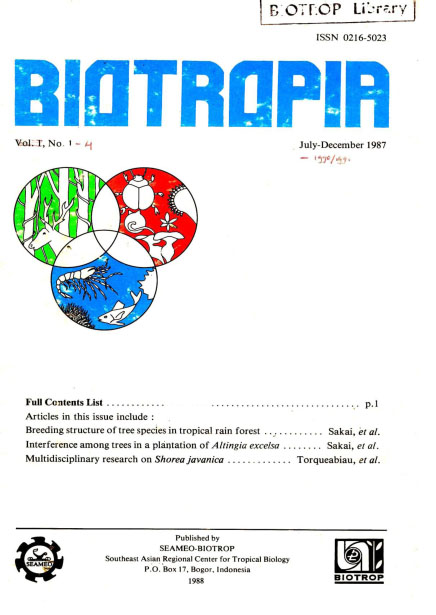
SEAMEO BIOTROP
Southeast Asian Ministers of Education Organization
884
views
Tags
STUDIES ON THE BREEDING STRUCTURE OF TREE SPECIES IN THE TROPICAL RAIN FOREST. I: FAMILY CLUMPS AND INTRAPOPULATION DIFFERENTIATION
24 May 2019 - 09:14 am (7 year ago)
Content Language : English
Content Language : English

Category :
Applied Science
Breeding structures of two tropical rain forest tree species, Altingia excelsa in Java and Agathis borneensis in Kalimantan were investigated. Assuming that similarity in the assortment pattern of the isoperoxidase bands tells genetic relationship between trees, on the one hand, and that inbreeding increases smaller values of the disagreement counts, on the other, it has been concluded that inbreeding occurs considerably in Altingia excelsa and to some extent in Agathis borneensis. Finding that trees showing very
low disagreement counts are located close to each other, they were grouped as an assumptive family. It was found that different families were quite dissimilar with respect to isoperoxide constitution and in several leaf characters as well. The distance between two trees at which they can mate is estimated to be 16 to 18 meters or 16.5 meters and the area one family occupies is 200 to 250 m^, assuming that a family clump can be a breeding unit in Altingia excelsa, within which trees mate at random. Some families were distributed mixed with each other within the mating distance, but they were found still genetically differentiated from each other. This
reproductive isolation among families is interpreted to be due to genetic differences between families in flowering time. In Agathis borneensis, there was no indication of family clump formation. Related trees may have been widely scattered in the forest, and the inbreeding of the species may be due to self-fertilization of individual trees and not to outcrossing between relatives.
low disagreement counts are located close to each other, they were grouped as an assumptive family. It was found that different families were quite dissimilar with respect to isoperoxide constitution and in several leaf characters as well. The distance between two trees at which they can mate is estimated to be 16 to 18 meters or 16.5 meters and the area one family occupies is 200 to 250 m^, assuming that a family clump can be a breeding unit in Altingia excelsa, within which trees mate at random. Some families were distributed mixed with each other within the mating distance, but they were found still genetically differentiated from each other. This
reproductive isolation among families is interpreted to be due to genetic differences between families in flowering time. In Agathis borneensis, there was no indication of family clump formation. Related trees may have been widely scattered in the forest, and the inbreeding of the species may be due to self-fertilization of individual trees and not to outcrossing between relatives.
Link

This work is licensed under a Creative Commons Attribution-NonCommercial-NoDerivatives 4.0 International License.
